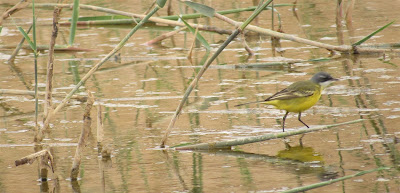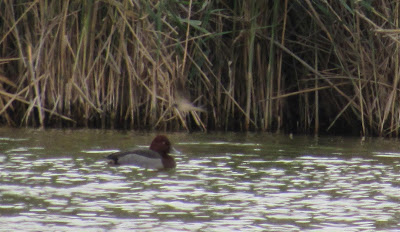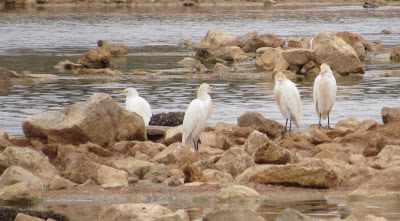On Thursday, I visited the oasis and stayed for over five hours. It could have been longer but I had to get back to the hotel.
I saw 54 species on an overcast day.
The taxi driver dropped me off at the far east of the oasis. When I left the taxi I wondered what all the fuss was about as all I could see was a dry but very wide bed and some patches of tamarisk.
However, my initial disappointment was ameliorated slightly by the sight of a white-crowned wheatear.
young white-crowned wheatear
I headed west. I soon came across a first area of water. It had reeds. Those reeds held no fewer than five sedge warbler.
sedge warbler
I presume they were a passage group with such a number in a confined area.
common snipe
Other noteable birds here were common snipe and yellow wagtail.
yellow wagtail
I found it interesting that there were more yellow wagtail at the oasis than white wagtail despite its northern location and still being winter.
black winged stilt
The further west I walked the more water there was in the wadi. The water was deep enough for black-winged stilt.
northern shoveller
I found my first ducks. There was a group of northern shoveller and also a single Eurasian teal.
Eurasian teal
Ironically it was the only Eurasian teal I saw on site.
greater flamingo
In the middle part of the oasis there were large numbers of greater flamingo, common moorhen and glossy ibis.
common moorhen
There were several ruddy shelduck.
ruddy shelduck
Laayoune is certainly one of the most important sites for wintering marbled duck. I saw well over 50. They were most prevlaent in the mid sector and the western end of the oasis.
marbled duck
As well as black-winged stilt, its cousin, pied avocet, was present.
pied avocet
The deepest water is on the western side of the oasis and in particular on the southern bank.
Here the water was deep enough to attract black-necked grebe.
black-necked grebe
A similar number of little grebe were observed and the two species associated.
black-necked grebe (l) little grebe (r)
While there were several tens of gulls present, for the most part they were either black-headed gull or lesser black-backed gull.
black-headed gull
Birds of prey seen were initially restricted to marsh harrier and common kestrel.
marsh harrier
I made a small detour away from the water's edge to a near-by wooded area. Here were no fewer than three black redstart.
squacco heron
The diversity continued. Grey heron and squacco heron had a preference for this western side.
Audouin's gull
On a rock in relatively deep water was an Audouin's gull. It was the only one of a third species of gull observed at the site.
two gulls
marsh harrier with kill
As I walked further west, I spotted a marsh harrier with a kill. It seemed to be a male northern shoveller.
hybrid pochard x ferruginous duck
The water was deep enough in places to attract common pochard.This is a diving duck and requires deeper water than dabbling ducks. There are relatively few sites in the Sahara which they are attracted to. The bird above was with four common pochard ia a hybrid. Thanks to those who commented. I checked with experts who have identified the type of hybrid. Unfortunately I can't reply to comments to the blog anymore. Somehow google have produced a recent bug preventing me from doing so!
Eurasian spoonbill
Eurasian spoonbill were numerous.
osprey
Over the deep water at the western end, a pair of osprey flew over a few times. I still don't know whether the water contains fish.
Eurasian coot
This western end kept giving more and more species. There were tens of Eurasian coot. However four white stork, near-by, were a surprise.
white stork
They were found at the extreme western part of the water body. I made my way back after I saw them. I went back with a brisk walk as time was now limited. I didn't get much chance to bird. However a flock of cattle egret were too large and numerous to miss.
cattle egret
The birding had fully lived up to expectations but even with five hours, it felt a bit rushed. I thought it was worth a second look two days later. That time my birding concentrated on the adjacent bushes and cliffs to the water. I was rewarded with a further six species not seen on Thursday. I will blog about that next.
54 species seen on Thursday 15th February at Laayoune
Ruddy Shelduck
Northern Shoveller
Common Pochard
Marbled Duck
Tufted Duck
Little Grebe
Black-necked Grebe
Greater Flamingo
Greater Flamingo
White Stork
Grey Heron
Little Egret
Cattle Egret
Squacco Heron
Glossy Ibis
Eurasian Spoonbill
Osprey
Western Marsh Harrier
Common Moorhen
Eurasian Coot
Black-winged Stilt
Pied Avocet
Common Ringed Plover
Little Ringed Plover
Black-tailed Godwit
Ruff
Little Stint
Common Snipe
Common Sandpiper
Green Sandpiper
Wood Sandpiper
Common Redshank
Black-headed Gull
Audouin's Gull
Yellow-legged Gull
Lesser Black-backed Gull
Feral Pigeon
Collared Dove
Eurasian Hoopoe
Common Kestrel
Southern Grey Shrike
Barn Swallow
Common House Martin
Common Chiffchaff
Iberian Chiffchaff
Sedge Warbler
Bluethroat
Black Redstart
European Stonechat
White-crowned Wheatear
Black Wheatear
Black-eared Wheatear
Western Yellow Wagtail
White Wagtail
House Sparrow



























Rob, there is something odd about your photo of Tufted duck. The head shape is not right and neither is the bill pattern. I was going to suggest that it looks more like a fudge - but suspect it is more of a hybrid TuftedxPochard but would need more/better photos to confirm. Great Blog by the way
ReplyDeleteOr a male tufted X ferruginous hybrid.
ReplyDeleteIf I were you I would send it to the Go-South website on Maroc birds.
Nice blog by the way!